3D Data Visualization Software, a powerful tool, brings data to life with stunning visualizations. In today’s data-driven world, understanding complex information is crucial, and 3D data visualization software plays a pivotal role in making this possible. It’s a game-changer in data analysis, allowing users to explore information more effectively. This software makes complex data sets accessible, making decision-making a breeze. This introductory paragraph explores the top 3D data visualization software, highlighting their unique features and capabilities.
Top 3 Gigs
One of the top contenders in the world of 3D Data Visualization Software is Tableau. It empowers users to create interactive and dynamic 3D graphs and charts, providing a deeper insight into data. Tableau’s user-friendly interface ensures that even non-technical individuals can harness its potential for data-driven decision-making.
Another standout in this arena is D3.js, a JavaScript library renowned for its flexibility and versatility. D3.js enables developers to craft custom 3D visualizations tailored to specific data needs. Its open-source nature and active community support make it an ideal choice for those seeking unparalleled customization in data visualization.
Lastly, there is Power BI, a Microsoft product known for its robust 3D data visualization capabilities. Power BI seamlessly integrates with various data sources, making it ideal for businesses looking to harness their data for informed decision-making. Its extensive library of pre-built visualizations simplifies the process of transforming data into compelling 3D graphics, making it accessible to users of all backgrounds.
3D data visualization software represents the forefront of data analysis and communication. They empower users to convey complex information intuitively and visually appealingly, making data-driven insights accessible. Choosing the best software depends on your specific needs, including ease of use, compatibility, and the variety of visualization options available. With the right tool in hand, you can unlock the potential of your data and present it in a compelling and accessible manner.
In this article, you delve deeper into the capabilities of each 3D data visualization software. You will uncover their unique strengths and applications in diverse fields.
List of the 10 Best 3D Data Visualization Software
In today’s data-driven landscape, selecting the right 3D data visualization software is paramount. These tools empower users to transform complex data into immersive and informative visualizations. Here are the top 10 options, each with a brief description.
1. Tableau: Tableau offers interactive 3D visualizations for in-depth data exploration and analysis.
2. D3.js: A JavaScript library for creating custom 3D data visualizations on the web.
3. Blender: Blender’s 3D modeling and rendering capabilities can be used for data visualization projects
4. QlikView: QlikView offers dynamic 3D dashboards for real-time data insights and decision-making.
5. Unity3D: Unity3D is a versatile platform for creating interactive 3D data visualizations and simulations.
6. ParaView: ParaView is an open-source tool for scientific data visualization in 3D and beyond.
7. Microsoft Power BI: Power BI supports 3D mapping and visual storytelling for business intelligence.
8. Plotly: Plotly provides 3D graphing and visualization capabilities for data scientists and analysts.
9. FusionCharts: FusionCharts provides 3D charting and graphing options for web applications and reports.
10. Rhino 3D: Rhino 3D is known for its 3D modeling capabilities, making it useful for unique data visualizations.
These software options cater to various needs, from business intelligence to scientific research. Each software offers a wide range of 3D visualization capabilities.
Reviews Of Best 3D Data Visualization Software
They facilitate realistic simulations and models for various industries. 3D visualizations captivate audiences and convey information effectively.
These Leading software offer compatibility across multiple platforms and devices. Users can interact with data, zoom in, rotate, and dissect it. Best 3D data visualization software allows customization of data displays.
They support diverse data types, from geographic to scientific. These tools foster collaboration among team members and stakeholders. 3D visualization aids in spotting trends and patterns.
Advanced software incorporates predictive analytics for informed decisions. Accurate representations help in identifying errors and anomalies quickly. Users can create compelling data-driven narratives for reports. 3D visualizations help in identifying data clusters and outliers. Leading software can export models for 3D printing. These tools find applications in healthcare, engineering, finance, and more.
Furthermore:
For industries like aviation, simulations aid in pilot training. They assist in risk assessment and mitigation strategies. 3D data visualization aids in product prototyping and design. Users can export data for further analysis in other tools. It helps to optimize resource allocation and utilization. For urban planning, this software engages the public in decision-making. This softwares Facilitates discovering hidden insights in vast datasets.
3D data visualization software enhances financial analysis by providing dynamic visuals. These tools facilitate the exploration of complex financial datasets effectively. They enable users to identify trends, patterns, and anomalies swiftly.
Top 3D data visualization software facilitates the recognition of emerging trends. These tools empower users to discern emerging trends effectively. They enhance trend detection by providing immersive 3D data representations.
This 3D data visualization software enhances transparency by simplifying complex data. It promotes understanding, aiding informed decision-making within data-driven organizations. Interactive 3D models engage stakeholders, fostering collaboration and improved comprehension.
Leading 3D data visualization software integrates IoT data for real-time analysis. These tools facilitate dynamic visualizations, aiding efficient IoT data monitoring. They empower users to create interactive, informative dashboards for real-time insights.
In conclusion, the best 3D data visualization software offers many advantages across various sectors.
Tableau
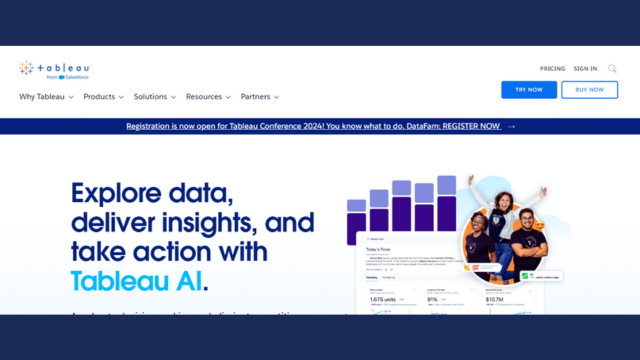
Tableau 3D data visualization software offers numerous advantages for data analysts, business professionals, and organizations seeking deeper insights from their data. Its capabilities extend beyond traditional 2D visualizations, providing a dynamic, immersive experience that enhances data exploration and decision-making. Below, you can delve into the key features that make Tableau’s 3D data visualization a valuable asset:
Versatility In Data Representation:
Firstly, Tableau 3D offers unparalleled versatility in data representation. Its ability to convert raw data into vivid 3D visualizations enables users to explore information from various angles, uncovering hidden patterns and relationships. This dynamic visual approach fosters a deeper understanding of data, empowering users to make more informed decisions.
User-friendly interface
Secondly, Tableau 3D provides an interactive and user-friendly interface. Its intuitive drag-and-drop functionality allows users to create 3D charts and graphs effortlessly, eliminating the need for complex coding or data manipulation. This accessibility extends to users of all skill levels, making data analysis more inclusive and efficient.
3D supports real-time data connections
Moreover, Tableau 3D supports real-time data connections. Users can connect to live data sources, ensuring their visualizations reflect the most up-to-date information. This real-time capability is invaluable in fast-paced industries where timely insights are crucial for success.
Data Storytelling
Tableau 3D also excels in data storytelling. Users can create interactive dashboards and stories that convey insights compellingly and engagingly. This feature is particularly advantageous when presenting findings to stakeholders or team members, as it simplifies complex data into digestible narratives.
Data Security
Furthermore, Tableau 3D prioritizes data security. It offers robust encryption and authentication measures to safeguard sensitive information. This commitment to data protection is essential for organizations that deal with confidential or regulated data.
Pros
- Tableau offers a user-friendly interface.
- It seamlessly integrates with various data sources.
- Tableau enables real-time data analysis.
- It has a vibrant user community.
Cons
- Costly Licensing.
- Steeper Learning Curve.
- Large datasets and complex.
- Visualizations may strain system resources.
D3.js

D3.js, a renowned 3D data visualization software, revolutionizes data presentation. Its many capabilities make it a go-to choice for data analysts, scientists, and developers worldwide. With its cutting-edge features, D3.js empowers users to create immersive and informative 3D visualizations that engage and provide deep insights into complex data sets.
Unparalleled Customization:
D3.js grants users unparalleled control over every element, allowing them to create unique and tailored 3D visualizations effortlessly.
Interactivity:
The software excels in interactivity, enabling users to create dynamic 3D visuals that respond to user input, enhancing the user experience.
Scalability:
D3.js is designed to handle large data sets efficiently, ensuring that even extensive datasets can be visualized in 3D.
Compatibility:
It seamlessly integrates with HTML, CSS, and SVG, making it accessible across various platforms and browsers without compatibility issues.
Community Support:
D3.js boasts a vibrant community of users and developers who actively contribute, providing extensive documentation and resources for users of all skill levels.
Efficiency:
With its efficient data binding and manipulation techniques, D3.js minimizes the need for repetitive coding, saving valuable development time.
Modularity:
The software’s modular approach allows users to reuse components and easily update or modify visualizations.
Rich Data Visualization Options:
D3.js offers various 3D visualization options, from bar charts and scatter plots to more complex visualizations like force-directed graphs and 3D maps.
Real-time Updates:
Users can implement real-time data updates, ensuring their 3D visualizations stay current and relevant.
Pros
- D3.js enables dynamic data visualization
- It offers extensive flexibility for customizing.
- D3.js has a solid and active community
- It works well with other web technologies and libraries, enhancing its integration capabilities.
Cons
- Time-consuming
- Compatibility issues may arise
- Lack of built-in features.
Blender
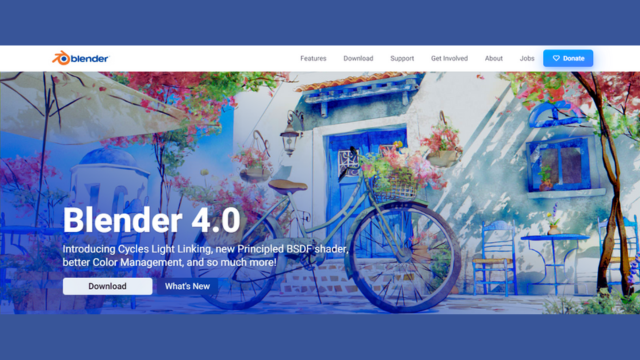
Blender 3D data visualization software is a beacon of data analysis and presentation innovation. This powerful tool simplifies the complex process of visualizing data and offers a wide array of features that empower users to create stunning and insightful visualizations. This article will explore the advantages of using Blender for 3D data visualization, shedding light on its transformative capabilities.
Enhanced Data Interpretation:
Blender allows users to transform raw data into interactive 3D visualizations, making it easier to grasp complex information.
Dynamic Charts and Graphs:
Users can create dynamic charts and graphs responding to real-time data changes.
Customization:
Blender offers unparalleled customization options, enabling users to tailor visualizations to their needs.
Data Integration:
It seamlessly integrates with various data sources, including spreadsheets and databases.
3D Models:
Blender’s 3D modeling capabilities allow for the creation of immersive data-driven environments.
Animation:
Users can animate data visualizations, making it ideal for storytelling and presentations.
Interactivity:
It supports interactive elements such as clickable data points for deeper exploration.
Cross-Platform Compatibility:
Blender is available on Windows, macOS, and Linux, ensuring accessibility for all users.
Open-Source:
Being open-source, Blender is cost-effective and continually improved by a vibrant community.
Scalability:
It handles vast datasets with ease, accommodating the needs of both small and large organizations.
Realistic Rendering
Blender’s rendering engine produces lifelike visualizations that enhance data understanding.
Multi-Dimensional Visualizations
Users can represent data in multiple dimensions, enabling in-depth analysis.
Pros
- Blender offers diverse rendering options for realistic visualization
- It’s free and open-source, making it accessible to a broad user base.
- Blender’s robust modeling tools enable complex data representations.
- A supportive community provides resources and plugins.
Cons
- Mastering Blender can be challenging for beginners.
- Complex visualizations may require substantial computing power.
- It needs some specialized data import/export options.
QlikView
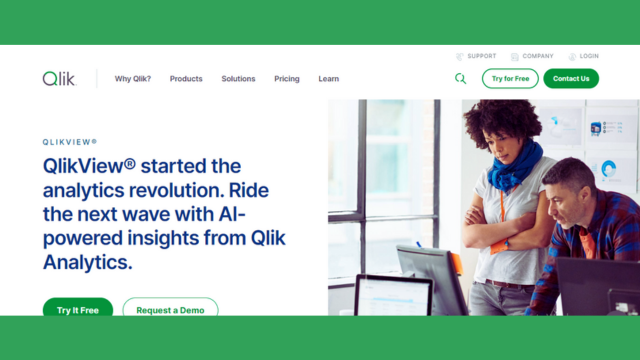
QlikView is a cutting-edge 3D data visualization software that empowers businesses to unlock the full potential of their data. With its advanced capabilities and intuitive interface, QlikView is a robust data analysis and visualization tool. In this article, we will explore the critical advantages of QlikView, highlighting its remarkable features and its benefits to users.
Flexibility
Firstly, QlikView offers unparalleled flexibility in data visualization. Users can create 3D visualizations that provide a more immersive and insightful view of their data, allowing for deeper analysis and better decision-making. This flexibility extends to customizing visualizations to meet specific business needs, ensuring that data is presented most meaningfully.
Data Integration
Secondly, QlikView excels in data integration. It seamlessly connects to various data sources, whether structured or unstructured, and consolidates them into a single, unified view. This feature streamlines the data preparation process, saving time and reducing the risk of errors. Users can access and analyze data from multiple sources in real-time, fostering data-driven decision-making.
Capability
Another noteworthy advantage of QlikView is its robust data exploration capabilities. Users can interact with 3D visualizations to explore data from different angles and perspectives. This dynamic exploration leads to discovering hidden insights and trends, empowering users to make data-driven decisions confidently.
Interface
Furthermore, QlikView offers a user-friendly interface that requires minimal training. Its intuitive drag-and-drop functionality makes it accessible to both technical and non-technical users. This accessibility promotes widespread adoption within organizations, ensuring that all stakeholders can harness the power of data.
Pros
- QlikView offers highly interactive and user-friendly dashboards for compelling data exploration
- Its associative data model enables easy data connections and dynamic insights.
- QlikView can handle large datasets and is suitable for enterprise-level applications.
- It supports collaborative analytics, allowing teams to collaborate on data analysis projects.
Cons:
- QlikView can be expensive, making it less accessible for small businesses
- Users may face a steep learning curve due to its complex features.
- Customization options are limited compared to some other data visualization tools.
Unity3D

Unity3D data visualization software offers numerous advantages for professionals and developers creating interactive and visually compelling data representations. This versatile platform empowers users with various features that streamline the process of creating immersive data visualizations.
Data Visualization
One significant advantage of Unity3D for data visualization is its robust 3D rendering capabilities, which enable users to create stunning visualizations that go beyond the limitations of traditional 2D charts. Its added dimensionality can enhance the understanding of complex data sets, making it easier for stakeholders to grasp intricate relationships within the data.
Functionality
Unity3D also provides a wide range of pre-built assets and templates specifically designed for data visualization, reducing the time and effort required to create engaging visualizations. These assets include customizable charts, graphs, and data-driven animations, allowing users to quickly prototype and iterate on their data visualization projects.
Versatility
Furthermore, Unity3D offers seamless integration with various data sources and formats, making importing data from spreadsheets, databases, and APIs easy. This versatility ensures users can work with their preferred data sources and maintain data integrity throughout the visualization process.
Platform’s Scripting
The platform’s scripting capabilities are another noteworthy feature, allowing developers to create custom interactions and animations tailored to their specific data visualization needs. Unity3D supports popular programming languages like C# and JavaScript, allowing developers to implement complex logic and interactions within their projects.
Pros
- Unity3D offers robust 3D rendering capabilities, enabling immersive and visually engaging data visualizations.
- It supports multiple platforms, making it versatile for reaching a broad audience.
- Unity’s asset store provides a wealth of resources for developers to enhance their data visualization projects.
- Unity3D allows for interactive data presentations, fostering user engagement and exploration.
Cons
- Beginners may find Unity3D challenging to grasp due to its complex interface and scripting requirements.
- Creating intricate data visualizations can demand significant computational power and memory.
- The Pro version of Unity3D comes with a licensing fee, which can be a drawback for small-budget projects.
ParaView
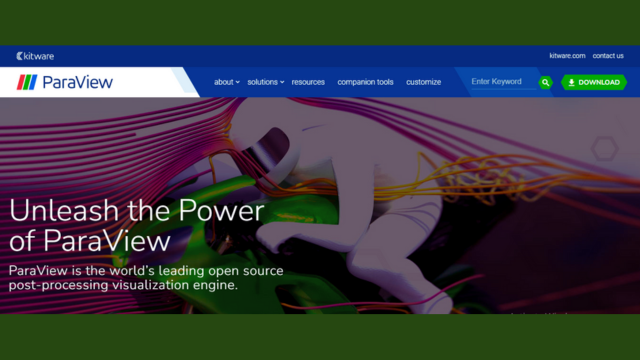
ParaView is a cutting-edge data visualization software that empowers users with remarkable capabilities. Its features, flexibility, and user-friendliness make it a standout choice for professionals across various industries.
Functionality
Firstly, ParaView excels in its ability to handle large datasets effortlessly. Its robust architecture efficiently processes data, ensuring that users can work with massive volumes of information without compromising performance. This scalability is invaluable for researchers, engineers, and analysts who deal with complex data regularly.
Ideal Tool
Secondly, ParaView boasts a versatile array of visualization options. Users can choose from an extensive library of visualization techniques, from 3D rendering to contour plots, enabling them to convey insights from their data effectively. This versatility makes ParaView a go-to tool for scientists and engineers in fluid dynamics, geophysics, and medical imaging.
Collaboration
Another key strength of ParaView is its open-source nature. It allows for a collaborative and ever-evolving community of users and developers who continually enhance the software. As a result, ParaView remains at the forefront of data visualization technology, staying current with emerging trends and technologies.
Versatility
Moreover, ParaView supports various data formats, ensuring compatibility with multiple data sources. Whether your data is structured as spreadsheets, simulations, or scientific datasets, ParaView can seamlessly import and work with it, making it an adaptable choice for professionals in diverse fields.
Interface
ParaView’s interactive features also shine. Its intuitive user interface allows for real-time exploration and manipulation of visualizations. This interactivity is essential for researchers and analysts who must make on-the-fly adjustments to gain deeper insights from their data.
Pros
- Paraview simplifies complex data visualization tasks with its user-friendly interface.
- Users appreciate Paraview’s powerful features for analyzing and rendering scientific data.
- Paraview’s open-source nature fosters collaboration and customization among researchers.
- With Paraview, 3D rendering and analysis have become accessible to diverse fields.
Cons
- Beginners may find it challenging to master due to its feature-rich interface.
- Handling large datasets can be demanding on system resources.
- ParaView primarily focuses on visualization, lacking a robust 3D modeling tool.
Microsoft Power BI

Microsoft Power BI is a powerful data visualization software offering numerous advantages for businesses and professionals. With its intuitive interface and robust capabilities, Power BI has become a go-to tool for data analysts, business intelligence experts, and decision-makers. This software empowers users to transform complex data into meaningful insights through interactive, visually appealing dashboards and reports. In this article, we will explore the key features and benefits of Microsoft Power BI, highlighting its impact on data-driven decision-making.
Efficient Data Integration:
Power BI allows users to effortlessly connect to a wide range of data sources, including databases, cloud services, and spreadsheets, ensuring that all relevant data can be utilized for analysis.
Intuitive Data Modeling:
The software provides a user-friendly data modeling environment, making creating relationships between different data sets easy and providing more accurate and comprehensive insights.
Interactive Visualizations:
Power BI offers a rich library of visualizations, such as charts, graphs, and maps, that can be customized and linked to create dynamic reports, making data exploration a breeze.
Real-time Updates
Users can set up real-time data refresh schedules, ensuring their dashboards and reports reflect the most up-to-date information.
Natural Language Queries:
Power BI supports natural language queries, allowing users to ask questions in plain English and receive relevant visualizations as answers, making it accessible to non-technical users.
Mobile Accessibility:
The software provides:
- A mobile app.
- Enabling users to access their reports and dashboards on the go.
- Fostering better decision-making even when away from the office.
Pros
- Power BI offers robust data visualization.
- Power BI scales well from small businesses to large enterprises.
- Accommodate diverse data needs.
- Users can customize and extend Power BI with custom visuals and plugins, tailoring it to their specific requirements.
Cons
- Advanced features and capabilities come with paid licenses, which can be costly.
- Limited Offline Access
- Power BI has limitations on data refresh frequencies for free and lower-tier permits, which may not suit real-time data needs.
Plotly

Plot data visualization software offers numerous advantages, making it a preferred choice for data analysts, scientists, and businesses. With its user-friendly interface and robust capabilities, Plotly empowers users to create stunning and interactive visualizations easily.
Versatility
One of Plotly’s key strengths is its versatility. It supports various chart types, including scatter plots, bar charts, line graphs, heat maps, etc. This versatility allows users to visualize data in multiple formats, catering to different analytical needs.
Features
Additionally, Plotly’s interactive features set it apart. Users can easily add tooltips, zoom in on specific data points, and pan across charts to explore in-depth data. This interactivity enhances data exploration and helps users uncover valuable insights.
Collaboration
Another standout feature of Plotly is its real-time collaboration capabilities. Multiple users can collaborate on a single project simultaneously, making it a valuable tool for data analysis or reporting teams. This feature streamlines workflow and fosters efficient teamwork.
Customization
The software’s extensive customization options empower users to tailor visualizations to their needs. From adjusting colors and fonts to adding annotations and legends, Plotly offers complete control over the appearance of charts. This level of customization ensures that visualizations align with branding and reporting requirements.
Pros
- Plotly enables the creation of interactive and engaging data visualizations.
- It supports multiple programming languages like Python, R, and JavaScript.
- Users can customize charts and graphs extensively to meet specific needs.
- Plotly has an active user community for support and resources.
Cons
- Some features may require a commercial license.
- More robust for complex 3D Visualizations compared to other tools.
- For massive datasets, performance can be a concern.
FusionCharts
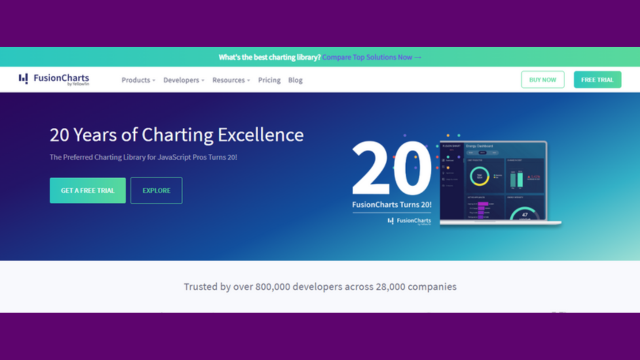
FusionCharts a pioneer in data visualization software, reigns supreme in data representation. Its innovative features, unparalleled versatility, and user-friendly interface make it the go-to choice for businesses and developers worldwide.
Extensive Library
First and foremost, FusionCharts dazzles with its extensive library of chart types. With over 90 chart types, you can effortlessly transform complex datasets into insightful visualizations, ranging from primary line and bar charts to advanced heat maps and treemaps. This diversity ensures you can choose the perfect chart type for any data scenario, enhancing clarity and comprehension.
Integration
Moreover, FusionCharts offers seamless integration across various platforms and programming languages, including JavaScript, PHP, and Python. It means you can effortlessly incorporate stunning visualizations into your web applications, mobile apps, and desktop solutions, ensuring a consistent and engaging user experience across all devices.
Interactivity
FusionCharts is renowned for its dynamic interactivity. Its interactive features empower users to explore data in-depth, enabling better decision-making. Furthermore, FusionCharts’ responsive design ensures that your charts adapt to different screen sizes, providing a flawless experience on desktop and mobile devices.
Accessibility
The software also prioritizes accessibility. FusionCharts complies with WCAG standards, making your charts accessible to individuals with disabilities. This inclusive approach ensures that your data visualizations reach a broader audience and adhere to regulatory requirements.
Pros
- Robust Visualization
- Cross-Platform Compatibility
- It supports multiple platforms and programming languages
- FusionCharts provides comprehensive documentation and support.
Cons
- Costly Licensing
- The free version has limited features, which might not suffice for complex data visualization needs.
- Extensive customization might be challenging, as it may require advanced coding skills.
Rhino 3D
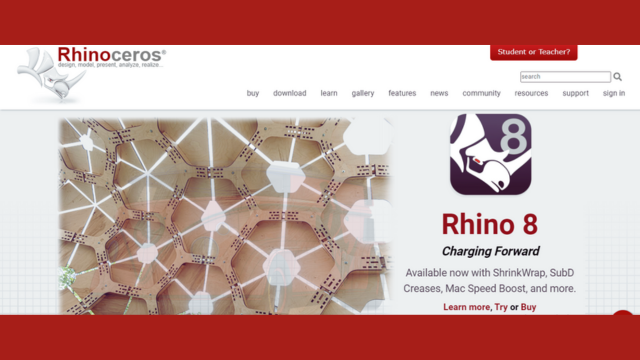
Rhino 3D data visualization software, a cutting-edge 3D modeling and visualization tool, offers many advantages that cater to professionals and enthusiasts alike.
Flexibility
Firstly, Rhino 3D provides unmatched flexibility in creating complex 3D models, allowing users to quickly bring their ideas to life. This flexibility extends to compatibility with various file formats, facilitating seamless data exchange between software applications.
User-friendly Interface
Secondly, the software boasts an intuitive and user-friendly interface, making it accessible to all skill levels. Its ease of use reduces the learning curve and increases productivity, as users can quickly translate their concepts into intricate 3D designs.
Extensive Library
Furthermore, Rhino 3D offers an extensive library of plugins and add-ons, enriching the software’s capabilities and enabling users to tailor it to their needs. These plugins cover various functions, from rendering and animation to parametric design and simulation, ensuring that Rhino 3D can adapt to diverse project requirements.
Modeling Tools
The software’s robust modeling tools deserve special mention, as they empower users to create intricate and precise geometries with unparalleled accuracy. Whether for architectural designs, industrial prototypes, or artistic sculptures, Rhino 3D’s modeling capabilities meet the most demanding design challenges.
Collaboration
Collaboration is made seamless with Rhino 3D through its compatibility with various design and CAD software, ensuring smooth integration into existing workflows. This interoperability enhances teamwork and facilitates project coordination, making it an excellent choice for collaborative environments.
Pros
- Versatile modeling capabilities for complex 3D designs.
- Extensive plugin support for specialized tasks.
- Robust surface modeling and NURBS tools.
- Cross-platform compatibility (Windows and macOS).
Cons
- The steeper learning curve for beginners.
- Limited parametric modeling compared to dedicated software.
- Rendering capabilities may require third-party plugins.
Buying guide for best 3D data visualization software
In the world of data analysis, the ability to present complex information in a visually compelling way is invaluable. 3D data visualization software is crucial in this process, offering powerful tools to create interactive and informative 3D visualizations. This guide will explore the top 3D data visualization software options, highlighting their key features, use cases, and pricing to help you decide on your data visualization needs.
Understanding 3D Data Visualization
Before diving into specific software options, it’s essential to understand the concept of 3D data visualization. This article will explain the significance of 3D visualization, its advantages, and how it differs from traditional 2D representations.
Criteria for Choosing 3D Data Visualization Software
Key Features to Look For:
User-friendly interface for accessible data import and manipulation.Support for various data formats and integration capabilities. Customization options for creating unique visualizations.Interactivity and collaboration tools for data sharing.Compatibility with different devices and platforms.
Top 3D Data Visualization Software:
Mention the names and briefly describe each software. Highlight their strengths and areas of specialization.
Detailed Software Reviews:
In-depth reviews of each software’s features, pros, and cons.Real-world use cases and examples of effective visualization.
Pricing and Licensing Models:
Explain the pricing structures and available plans. Consider the affordability and scalability of each option.
Compatibility and Integration:
Discuss how well the software integrates with other tools. Highlight compatibility with familiar data sources.
User Experience and Support:
Evaluate the software’s user interface and learning curve—availability of customer support, tutorials, and documentation.
Data Security and Privacy:
Address data security concerns and encryption features—compliance with data privacy regulations (e.g., GDPR).
Case Studies and Success Stories:
Showcase examples of businesses benefiting from each software. Explain how they solved data visualization challenges.
Future Trends and Updates:
Discuss emerging trends in 3D data visualization: software updates and roadmap for continued improvement.
Making Your Decision:
Summarize the key factors to consider in your decision. Encourage readers to try out free trials or demos.
1. Identify Your Objectives: Clarify your specific 3D data visualization goals.
2. Compatibility Matters: Ensure the software is compatible with your hardware.
3. Ease of Use: Use user-friendly software to reduce the learning curve.
4. Data Import: Verify that it supports various data formats for seamless integration.
5. Customization: Look for software that allows customization of visualizations and dashboards.
6. Performance: Check for smooth rendering and handling of large datasets.
7. Interactivity: Prioritize software with interactive features for data exploration.
8. Data Sources: Consider if it can connect to your preferred data sources.
9. Security: Assess the software’s data security and encryption capabilities.
10. Scalability: Choose software that can grow with your expanding needs.
11. Cost: Compare pricing models, including one-time purchase or subscription-based.
12. Support & Updates: Ensure timely support and regular software updates.
13. User Community: A vibrant community can provide valuable insights.
14. Reviews & Testimonials: Review reviews and seek trusted sources’ recommendations.
15. Trial Period: Utilize trial versions to test compatibility and features.
16. Data Visualization Types: Confirm it supports the specific visualization types you need.
17. Export Options: Check for export options, like image and video formats.
18. Integration: Evaluate if it integrates with your existing software stack.
19. Mobile Accessibility: Consider mobile-friendly options for on-the-go access.
20.3D Modeling: If needed, ensure it offers robust 3D modeling capabilities.
21. Data Analysis Tools: Look for built-in data analysis tools for deeper insights.
22. Collaboration Features: Assess collaboration tools for team projects.
23. Templates & Themes: Pre-designed templates can save time and effort.
24. Data Connection Speed: Ensure data connections are efficient and fast.
25. Compliance: Verify if the software complies with applicable industry regulations.
26. Training & Documentation: Access to training materials can facilitate learning.
Customer Support Channels:
Multiple support channels enhance problem-solving.
Scalable Pricing:
Choose pricing that aligns with your budget and scalability.
Feedback & Improvement:
Check if the software actively incorporates user feedback.
Backup & Recovery:
Data safety measures should include backup and recovery.
User Limitations:
Ensure no user limitations hinder scalability.
Long-Term Viability
Assess the company’s stability and development plans.
User Experience:
Consider the overall user experience and interface design.
Case Studies
Review case studies to see real-world applications.
Competitor Analysis:
Compare software with similar alternatives in the market.
Licensing Terms:
Understand licensing terms and any hidden costs.
Data Refresh Frequency:
Check how often the data can be refreshed.
GDPR Compliance:
Ensure compliance with data privacy regulations like GDPR.
Cross-Platform Support:
Compatibility with different operating systems can be crucial.
Final Decision:
Based on your evaluation, make an informed software choice.
By following these steps and carefully evaluating your options, you can confidently choose the best 3D data visualization software to meet your unique requirements and achieve your visualization objectives.
She frequently asked questions (FAQs) about the best 3D data visualization software.
What is 3D data visualization software, and why is it important?
3D data visualization software is a tool that allows users to create interactive, three-dimensional representations of data. It is essential because it helps users gain insights from complex data sets by making patterns and relationships more visually apparent.
What are some key features to look for in 3D data visualization software?
Key features include the ability to import various data formats, support for interactive 3D visualizations, data analysis capabilities, customization options, and compatibility with different platforms.
What industries benefit the most from 3D data visualization software?
Healthcare, architecture, finance, and engineering industries benefit significantly from 3D data visualization software. It helps in better understanding and decision-making in these sectors.
Can you recommend some popular 3D data visualization software options?
Some popular options include Tableau, D3.js, Unity, Blender, and Autodesk Maya. Each of these has its unique features and use cases.
Is 3D data visualization software suitable for beginners or requires advanced skills?
The complexity of using 3D data visualization software varies, but many tools offer user-friendly interfaces suitable for beginners. However, advanced features may require more experience.
How can 3D data visualization software give benefit to organizations?
It can help businesses make data-driven decisions, identify trends, communicate information effectively, and gain a competitive edge in various industries.
Are there any free or open-source 3D data visualization software options available?
Yes, some open-source options like Blender and D3.js are available for free. They offer powerful 3D visualization capabilities without the cost of proprietary software.
What hardware requirements are necessary to run 3D data visualization software smoothly?
The hardware requirements vary depending on the specific software, but a powerful computer with a sound graphics card and ample RAM is generally recommended for smooth operation.
Can 3D data visualization software handle large datasets?
Many 3D data visualization software tools are designed to handle large datasets, but performance may vary depending on the complexity of the visualization and the hardware used.
How can I learn to use 3D data visualization software effectively?
You can learn through online tutorials, courses, and documentation provided by the software developers. Additionally, practice and experimentation are vital to mastering 3D data visualization.
Can 3D data visualization software integrate with other data analysis tools or platforms?
Many 3D data visualization tools offer integration options with data storage platforms, databases, and business intelligence tools to streamline the data analysis process.
What are some real-world examples of successful implementations of 3D data visualization software?
Companies like NASA use 3D data visualization to analyze space data, while healthcare institutions use it to visualize patient data for better diagnosis and treatment.
This set of FAQs provides an overview of 3D data visualization software, its benefits, features to consider, and guidance for beginners. It makes it easier for users to understand and select the right tool.
Final Thoughts
The realm of 3D data visualization software boasts remarkable versatility. These cutting-edge tools empower users to transform complex datasets into visually engaging and insightful presentations. By facilitating immersive exploration and analysis, they enhance decision-making across various industries.
Moreover, the best 3D data visualization software continually pushes the boundaries of innovation. They offer a dynamic range of features, ensuring adaptability to evolving data needs. With real-time rendering and interactivity, these programs usher in a new era of data-driven storytelling. The three most famous software are:
- Tableau enables interactive data exploration and visualization with user-friendly dashboards.
- D3.js empowers developers to create dynamic, custom data visualizations for web applications.
- Power BI offers robust 3D data visualization capabilities for insightful reporting.
The software’s evolution is ongoing, with constant advancements in technology and interface design and the integration of artificial intelligence to provide real-time insights and predictive analytics. As 3D data visualization tools become increasingly user-friendly and readily available, they have the potential to become a standard tool in various industries.
Nonetheless, adopting 3D data visualization software raises challenges, including data security and privacy concerns, the need for specialized skills, and the potential for information overload. As we move forward, it is essential to address these issues while harnessing the full potential of this technology.
Lastly, the significance of 3D data visualization software in contemporary data-driven ecosystems cannot be overstated. As we navigate an increasingly data-rich landscape, these tools serve as invaluable allies. They bridge the gap between raw information and actionable insights, promoting a deeper understanding of complex phenomena and driving progress in diverse fields.
Next Article: Best International Domain Name Registration

